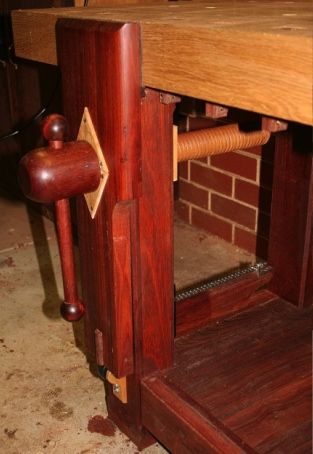 Thanks: 0
Thanks: 0
 Needs Pictures: 0
Needs Pictures: 0
 Picture(s) thanks: 0
Picture(s) thanks: 0
Results 1 to 3 of 3
Thread: Parallel Guide Guide
-
10th October 2012, 12:58 AM #1
 Parallel Guide Guide
Parallel Guide Guide
No, that's not an echo ..

All vises have a little play/slop in the screw. This is normal. If there was none then the screw would bind.
Play is a double edged sword – play leads to racking, and racking in a leg vise is desirable when clamping out-of-square pieces. However, racking also then favours one side of the chop over the other, and greater cranking force is required to keep the piece from tipping.

My leg vise uses a wooden screw and has a little play. I was very careful when building the leg vise. Indeed, for those who followed my build, they have seen pictures of the installation (twice – the second when I added the chain adjuster). Everything was square, square, square … and solid.
Very little force is required for sufficient holding power with this vise (about 1/4 turn once the chop makes contact).
When it was new the chop would clamp down squarely and hold with just a little force. No racking. As it wore in, the racking seemed to increase a little, and then the chop began to reveal more clamping strength on one side. In my case there seemed to be a tiny amount less holding power on the “outfeed” side of the vise (the left of the vise in the picture below), which may have occurred as a result of planing edges (i.e. that is where the plane ends and greater downforce is created). This small amount was enough to cause the vise to rack enough to reduce the holding power.

There is nothing worse, as you plane, than the board twisting and dropping down - damaging to yourself and the edge being planed.
I imagine that there would be less play in a high quality ACME metal screw, such as from LN or BenchCrafted. A wooden screw is less precise. I imagine that others experience the same as I do. I’d like to hear if this also affects you. If you are unhappy with this issue, then there is a simple fix.
The problem is not simply the screw, but also the parallel guide. They work together. The parallel guide must also have a tad leeway to avoid it binding in the leg through mortice. Even 1mm of leeway will translate into play in the screw, and from there to the chop. The aim is to get – and hold – everything perfectly square, in such a way that the pressure across the chop is equal, and stays that way.
The fix is at the parallel guide. The parallel guide requires a guide to keep it tracking squarely. In my case, the parallel guide was shifting to the left.
My solution was to groove a section of hardwood that the guide could run through, and add in adjustability so that the exact support could be dialled in. (Note: the parallel guide floats above the PG guide. It does not rest on it).
Your set up would look like this if your parallel guide is built the same way as mine. (Note that the groove/mortice in mine is not centred – not to worry. In my case this does not matter. I was testing out the idea, but it worked so well that I have left it as is).

Simply slide under the parallel guide (as in my case). If you cannot do this, there are other ways to build a fence that keeps the parallel guide tracking square.

Adjust for squareness, and you will find that the amount of force to clamp work decreases significantly.
Regards from Perth
DerekVisit www.inthewoodshop.com for tutorials on constructing handtools, handtool reviews, and my trials and tribulations with furniture builds.
-
10th October 2012 12:58 AM # ADSGoogle Adsense Advertisement
- Join Date
- Always
- Location
- Advertising world
- Posts
- Many
-
10th October 2012, 12:35 PM #2

Was this a problem before you fitted the chain ? Is the chain the cause ?
Cheers, Bill
-
10th October 2012, 04:52 PM #3

Hi Bill
No to both. I think that this is just a feature of a leg vise.
I emphasise that this is about super tuning the set up. I want to be able to clamp securely with the least amount of force. That tells me that all is working well, and assures me that the work piece is less likely to slip. Someone else may just crank the handle more, but this disguises that there is an imbalance in the system.
Regards from Perth
DerekVisit www.inthewoodshop.com for tutorials on constructing handtools, handtool reviews, and my trials and tribulations with furniture builds.
Similar Threads
-
Leg vise Parallel Guide Adjuster by Ancora Yacht Service
By derekcohen in forum THE WORK BENCHReplies: 4Last Post: 10th July 2012, 05:54 PM -
How fast to reposition the guide on the Festool circular saw guide system?
By Icestation2 in forum FESTOOL FORUMReplies: 12Last Post: 4th July 2009, 10:37 AM -
Using Trend Guide Bushes with Triton TGA001 Template Guide Kit
By Chop 'n' Join in forum TRITON / GMCReplies: 1Last Post: 13th May 2008, 04:08 AM -
Guide to Zen
By DonN in forum WOODIES JOKESReplies: 3Last Post: 8th January 2005, 03:35 PM -
Guide Blocks Vs Guide Rollers...
By Dean in forum BANDSAWSReplies: 15Last Post: 20th February 2004, 12:37 AM



 Likes:
Likes: 


 Reply With Quote
Reply With Quote
